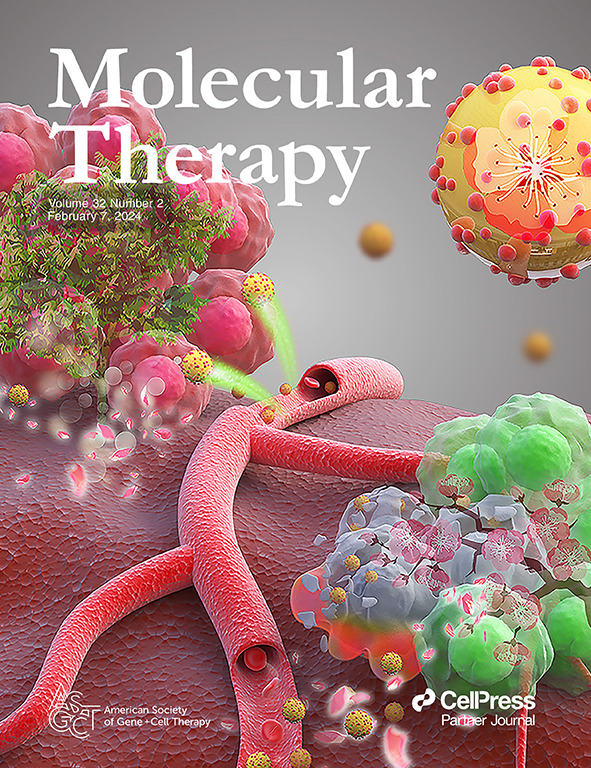AAV-delivered PPT1 provides long-term neurological benefits in CLN1 mice and achieves therapeutic levels in sheep brain.
IF 12.1
1区 医学
Q1 BIOTECHNOLOGY & APPLIED MICROBIOLOGY
引用次数: 0
Abstract
CLN1 disease is a fatal neurodegenerative condition caused by deficiency in Palmitoyl-Protein Thioesterase 1 (PPT1), for which no disease-modifying therapy exists. The disease affects the entire central nervous system (CNS), necessitating widespread delivery of therapeutics to the brain and spinal cord. Adeno-associated virus (AAV)-based PPT1 gene therapy delivered intrathecally has been tested in mouse models but has shown limited efficacy due to inadequate brain bioavailability. Here, to maximize therapeutic benefit, PPT1 was engineered for improved cross-correction capabilities, packaged in Spark100, a neurotropic AAV capsid, and administered through intracerebroventricular route in neonatal Ppt1-/- mice. This achieved sustained expression of PPT1 protein across the CNS, including key disease-relevant structures, for up to 15 months. It resulted in long-term therapeutic benefits, such as extended lifespan, preserved neurobehavioral function, and prevention of neuropathology, making treated Ppt1-/- mice nearly indistinguishable from WT. A translatability study in healthy adult sheep, assessing biodistribution of therapeutic in a large and fully developed brain, showed widespread CNS transduction and PPT1 expression with no adverse effects. These studies demonstrate the potential of this approach for treating CLN1 disease and suggest that a similar platform, using a secreted therapeutic protein, might apply to other neurological disorders with broad CNS deficits.aav递送的PPT1在CLN1小鼠中提供长期的神经学益处,并在绵羊脑中达到治疗水平。
CLN1疾病是一种致命的神经退行性疾病,由棕榈酰蛋白硫酯酶1 (PPT1)缺乏引起,目前尚无改善疾病的治疗方法。这种疾病影响整个中枢神经系统(CNS),需要向大脑和脊髓广泛输送治疗药物。基于腺相关病毒(AAV)的鞘内PPT1基因疗法已经在小鼠模型中进行了测试,但由于大脑生物利用度不足,疗效有限。在这里,为了最大限度地提高治疗效果,PPT1被设计用于改善交叉校正能力,包装在Spark100(一种嗜神经AAV衣壳)中,并通过脑室内途径给药于新生PPT1 -/-小鼠。这实现了PPT1蛋白在中枢神经系统(包括关键的疾病相关结构)中持续表达长达15个月。它带来了长期的治疗益处,如延长寿命、保持神经行为功能和预防神经病理学,使治疗过的Ppt1-/-小鼠与WT几乎没有区别。一项在健康成年绵羊中进行的可翻译性研究,评估了治疗在大而完全发育的大脑中的生物分布,显示了广泛的中枢神经系统转导和Ppt1表达,没有不良反应。这些研究证明了这种方法治疗CLN1疾病的潜力,并表明使用分泌治疗蛋白的类似平台可能适用于其他具有广泛中枢神经系统缺陷的神经系统疾病。
本文章由计算机程序翻译,如有差异,请以英文原文为准。
求助全文
约1分钟内获得全文
求助全文
来源期刊

Molecular Therapy
医学-生物工程与应用微生物
CiteScore
19.20
自引率
3.20%
发文量
357
审稿时长
3 months
期刊介绍:
Molecular Therapy is the leading journal for research in gene transfer, vector development, stem cell manipulation, and therapeutic interventions. It covers a broad spectrum of topics including genetic and acquired disease correction, vaccine development, pre-clinical validation, safety/efficacy studies, and clinical trials. With a focus on advancing genetics, medicine, and biotechnology, Molecular Therapy publishes peer-reviewed research, reviews, and commentaries to showcase the latest advancements in the field. With an impressive impact factor of 12.4 in 2022, it continues to attract top-tier contributions.
 求助内容:
求助内容: 应助结果提醒方式:
应助结果提醒方式:


